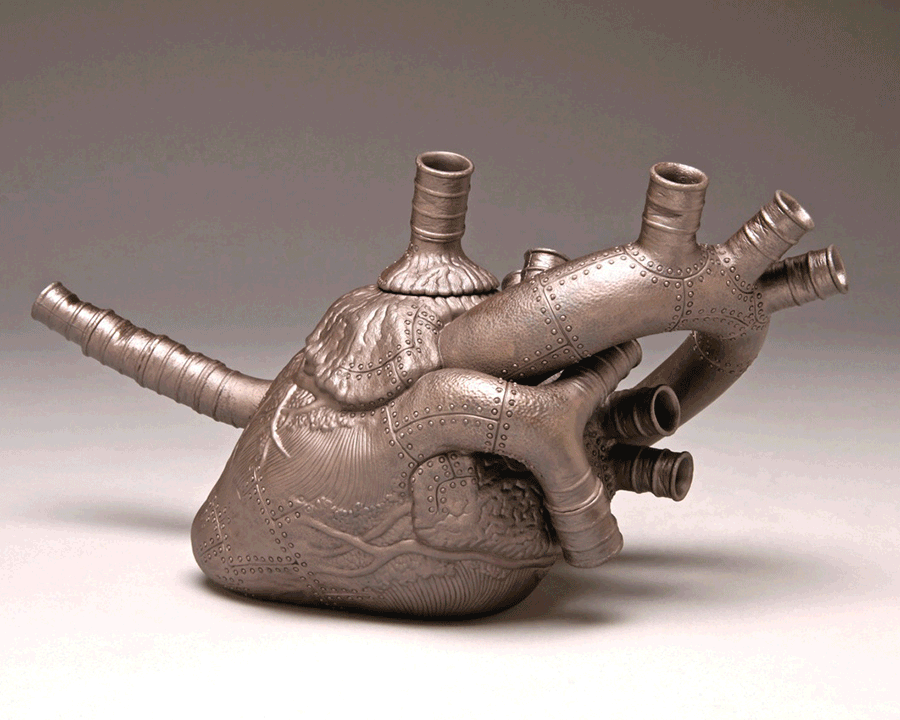Richard Notkin
Introducing the NWDC Artist Interview. Each month NWDC will highlight one of our members and get a closer look at their practice. Our first interviewee is one of our newest members but a stalwart of the Fine Craft community, Richard Notkin.
1. How were you introduced to art?
I wasn't. I was born that way. From my earliest memories, I drew, painted, and built things from scratch materials. I was the "class artist" from kindergarten through my senior year in high school, and I chose to go directly to art school rather than a university to begin a career — or, rather, a life — in art. The Kansas City Art Institute, with its revolutionary freshman Foundation Department in the mid-1960s, was a perfect fit for me. I went to be a painter, but was seduced by clay in my junior year in 1968, and have been mucking about in the mud ever since.
2. Where do you find inspiration when creating new work?
Most everywhere. My childhood upbringing, early Jewish education, exposure to Holocaust survivors, experiencing the Cuban Missile Crisis as a teenager and later the military draft during the Vietnam War, and currently, the world news — all of these have shaped my deepest convictions and passions. At 74, I have a renewed sense of fighting for my granddaughters' future. I am committed to political/social commentary, or as the late great John Lewis would say, "Good Trouble" in narrative ceramic art. I find little inspiration in the latest zeitgeist-driven fashions promoted by the high mucky-mucks of the elitist fine arts world, which seems mostly dominated by high finance. I have always followed my innermost passions and directions, which have usually been in opposition to the styles and directions of the art market du jour. While there are some great artists who are quite successful in the establishment fine arts world, there are also a lot of hucksters, snake oil salespersons, and parasites out there. The art world is not much different from the cultures of corporations, academia or politics. Human civilization is, quite simply, infested with human beings!
3. What do you consider your greatest artistic achievement?
The impact that my work and teaching efforts through workshops worldwide have had on many artists and emerging artists, and others. While I have not tried to be the evangelist political/social commentary ceramic artist of our time — the "Billy Graham of Clay" — I have been a staunch defender of the notion that, while art may not ultimately save human civilization from the greed-driven narcissists who continue to threaten its destruction, it has certainly made a difference up until now. Can you imagine human survival had it not been for the many forms of art and human creativity that have always distinguished our species as unique?
4. What is the quality you most like in an artist?
Honesty. Passion. Skill in technique and depth of concept and a highly developed personal aesthetic sensibility. Working from a uniquely individual place, recognized from deep within, not swayed by outer pressures of the marketplace, the changing winds of doctrine, and the aforementioned art world fashions du jour. As Thea von Harbou wrote as screenwriter for the film,Metropolis(Germany, 1927, directed by Fritz Lang), “There can be no understanding between the hands and the brain unless the heart acts as mediator.” I am for an art that still involves the heart.
5. Which living artist do you most admire?
Too many. And many dead ones, too, like Francisco Goya, and Robert Arneson, who was my professor and mentor when I was a grad student at the University of California/Davis, 1971-3. Living? Colleagues and friends, like Patti Warashina, one of my first great inspirations when I began to work in clay in the late 1960's, and she is still the best. Ehren Tool, another ceramist whose cups speak eloquently -- and simply -- of the horrors he experienced in the Desert Storm War. Tip Toland (my sister-in-law, and former student, who has taught me at least as much as I taught her), whose great figurative ceramic sculptures keep telling deeply psychological stories of our human condition, follies, foibles, and fears. The sculptor and printmaker John Buck. My partner in life and marriage, painter and printmaker Phoebe Toland. And many more whose art is guided by their innermost passions and concerns.
6. If you could change one thing about yourself, what would it be?
Absolutely nothing. Why change perfection? KIDDING! Well, actually, life is a series of mid-course corrections. I have fucked up as much as anyone else in this lifetime, but one must learn from mistakes, make corrections, and go on. I did some really dumb shit as a kid and teenager, and as an adult, too. But at this point in my life, I have a wonderful partner in Phoebe and a good life as an artist with friends and colleagues across the planet. If I changed anything, would it still be so? (But don't ask Phoebe this question...)
7. What is your most treasured possession?
Not a possession. Even a Jewish kid can appreciate what another young Jewish man once said about 2000 years ago regarding not "storing your treasures on earth, where moth and rust doth corrupt." Most treasured: My granddaughters, Ava and Sophie. Phoebe. Family, friends, and colleagues, etc.
8. Who has had a significant influence over your work?
Only a very few trusted family and friends. I listen to everyone, but only a few really understand deeply what I am trying to say in my art, and how I am trying to say it. Sometimes, someone really surprises me with an amazing revelation. I am not overly influenced by the Big Guns, the important critics and famous art world prognosticators, whose agendas are different from mine. On the other hand, I enjoy those who do not take themselves too seriously. In 2016, Jerry Saltz, an art critic who takes a realistic view of our craft, delivered the keynote address at the Kansas City NCECA conference, stating that “The art world is like high school with money.”
9. How has your studio practice changed
After 54 years of making art primarily in ceramic media, and experiencing an average of one solo exhibition annually during this time, I am now focussing on one last major work, which will occupy most of my time and studio space until I leave the planet in the unknown future. At that time, the work will be partially finished. But the anti-war, anti-nuclear weaponry messaging that has been a constant in my work for my entire life as an artist is also an unfinished work, and it seems it will be so for the foreseeable future. The idea that this evolving piece will be unfinished upon my passing is part of the concept. I pass this work on to the millions of creative people in all fields of endeavor throughout the world to continue to pursue. As Gandhi once expressed, and I paraphrase: Enough grains of sand will eventually stop even the mightiest of machines.
I won't make the teapot or sculpture that saves the world. It is a collective effort. I have contributed my grains of sand, joining countless others. And as Andre Malraux put it: "Every work of art is a revolt against man's fate." Hopefully, a peaceful revolt will bring about a peaceful fate.
10. What is your idea of perfect happiness?
A world in which peace and creativity dominate, a gradual elimination of the walls which separate us into different artificially created groups manipulated by fear and hatred. We were almost there at the end of the Cold War, moving past the disastrous wars of the 20th Century. The worldwide celebrations during the passage from December 31, 1999, to January 1, 2000, seemed to embrace this new spirit. But we have somehow continued to stumble on with the increasingly frightening technologies of Star Wars coupled with the emotional maturity of cavemen. This must change. We can and should return to a spirit of optimism and work to make our part of the planet a better place and teach our children to do likewise. Call me a wacko idealist, but I can't see it any other way. Better to live life as an optimist and work towards a positive future than the corollary. Demographics and the natural instinct to survive inherent in all species favor our children, grandchildren, and great-grandchildren. Hopefully, time is still on their side.
Richard Notkin is a full-time studio artist who lives and works on the Kitsap Peninsula in Washington State. He received a BFA from the Kansas City Art Institute in 1970, and an MFA from the University of California, Davis in 1973. Mr. Notkin has worked mainly in ceramics for more than thirty-nine years, averaging over one solo exhibition per year. His series of Yixing (China) inspired teapots and ceramic sculptures have been exhibited internationally and are in numerous public and private collections, including the Metropolitan Museum of Art in New York, the Smithsonian Institution in Washington, DC, the Los Angeles County Museum of Art, the Victoria and Albert Museum in London, and the Shigaraki Ceramic Cultural Park, Japan. He has held visiting artist positions and conducted over 250 workshops throughout the world. Among his awards, Richard has received three fellowships from the National Endowment for the Arts, as well as fellowships from the John Simon Guggenheim Memorial Foundation and the Louis Comfort Tiffany Foundation.
Images (Top to Bottom): “Heart Teapot: Internal Combustion Metamorphosis”- Yixing Series, 2013. Stoneware, luster 6.5" x 12.5" x 5" Photo credit: Tom Ferris | “Yesterday, Today and Tomorrow”, 2016. Mid-range stoneware, glaze 15” x 11.75” x 11.75” Photo credit: Richard Notkin | "The Last Syllable of Recorded Time", 2010. White earthenware, glaze, watercolor, and pastel, 77.5" x 51.5" x 2.5" Photo credit: Richard Notkin



